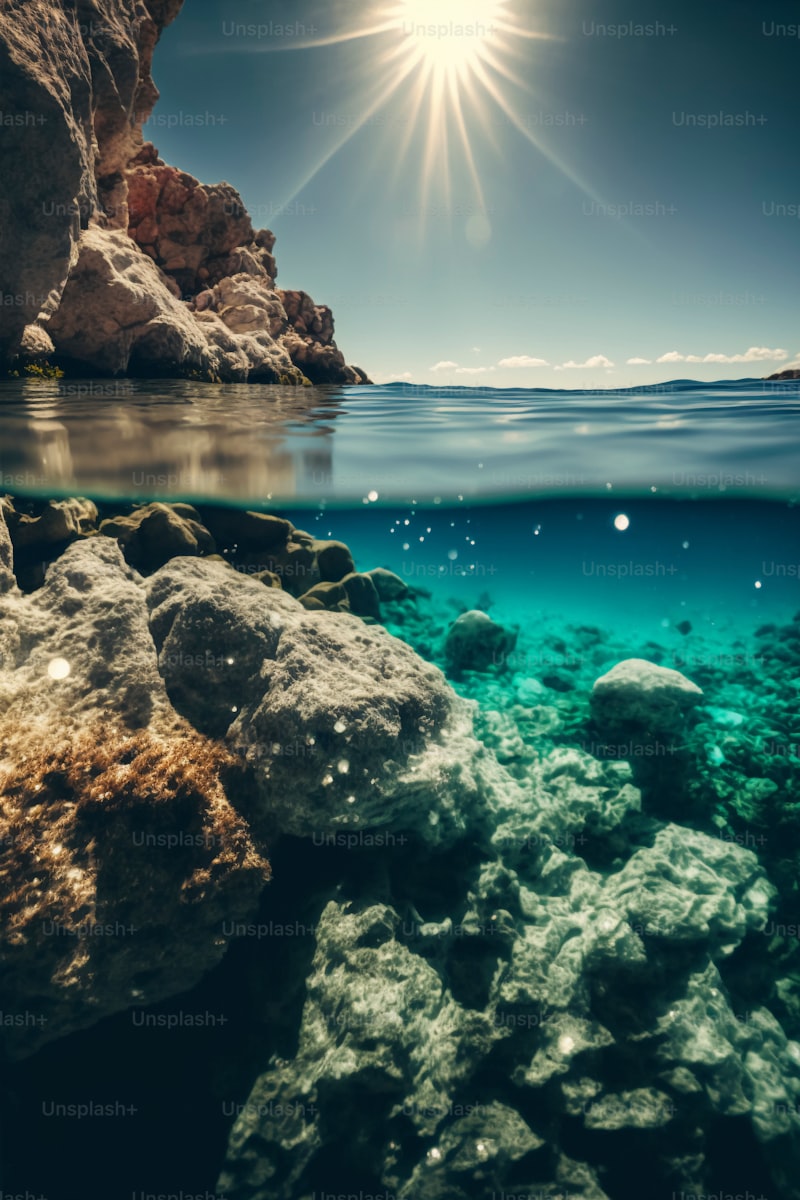But what exactly is ocean acidification? Simply put, it’s the ongoing decrease in the pH levels of the Earth’s oceans. This change is primarily caused by the uptake of carbon dioxide (CO2) from the atmosphere. When CO2 dissolves in seawater, it forms carbonic acid, which then dissociates into hydrogen ions, lowering the pH of the water and making it more acidic.
This acidity has far-reaching implications for marine life. Many marine organisms, such as corals, shellfish, and certain types of plankton, rely on calcium carbonate to build their shells and skeletons. However, in more acidic waters, calcium carbonate becomes scarcer and more difficult for these organisms to obtain. This can weaken their shells and skeletons, making them more vulnerable to damage and predators.
Additionally, ocean acidification can disrupt the entire food web of the ocean. For example, the tiny pteropods, also known as sea butterflies, are a crucial food source for many marine creatures, including fish and whales. These delicate organisms have shells that are particularly vulnerable to acidification, potentially affecting the entire marine food chain.
The implications of ocean acidification extend beyond marine life. Coastal communities that rely on fisheries for food and livelihoods may face economic challenges if fish populations decline due to changes in their habitats caused by acidification.
Understanding ocean acidification is crucial for addressing its impacts on marine ecosystems and human societies. By reducing our carbon footprint and taking steps to mitigate climate change, we can help alleviate the pressures contributing to ocean acidification and protect the diversity and health of our oceans for future generations.
The Silent Threat: Unraveling the Impact of Ocean Acidification on Marine Life
The implications for marine life are staggering. Many marine organisms, such as corals, shellfish, and certain types of plankton, rely on calcium carbonate to build their shells and skeletons. However, in more acidic waters, calcium carbonate becomes less available, making it harder for these organisms to maintain their structures. This weakened state not only threatens their survival but also has cascading effects throughout the marine food web.
Corals, for instance, are not just beautiful reef builders but also crucial habitats for countless species. As acidification weakens coral structures, reefs become more vulnerable to erosion and destruction. This not only diminishes biodiversity but also reduces the natural coastal protection they provide against storms and erosion.
Moreover, acidification affects fish populations, altering their behavior and physiology. Some studies suggest that acidification can impair fish larvae’s ability to detect predators, making them more susceptible to predation. Additionally, acidification can interfere with the sensory systems of fish, affecting their ability to navigate and find food.
While the impacts of ocean acidification are becoming increasingly evident, there is still much to learn about its long-term consequences. Addressing this issue requires concerted efforts to reduce carbon emissions and protect vulnerable marine ecosystems. By understanding and mitigating the effects of ocean acidification, we can safeguard the health and resilience of our oceans for future generations.
From Coral Reefs to Fisheries: How Ocean Acidification Is Reshaping Marine Ecosystems
Coral reefs, often hailed as the “rainforests of the sea,” are particularly vulnerable to ocean acidification. The structural integrity of coral skeletons, composed primarily of calcium carbonate, becomes compromised as acidity levels rise. This process, known as coral bleaching, not only threatens the vibrant biodiversity these reefs support but also undermines their role as crucial habitats and coastal protectors.
Fisheries, essential for global food security and economies, face a dual challenge from ocean acidification. Shell-forming organisms like mollusks and crustaceans struggle to build and maintain their shells in increasingly acidic waters, impacting their survival and reproduction rates. This disruption cascades through the marine food web, affecting commercially valuable fish stocks and the livelihoods of millions who depend on them.
Scientists and policymakers are increasingly alarmed by the cascading effects of ocean acidification. Research efforts are focused on understanding how different species respond to changing ocean chemistry and developing strategies to mitigate its impacts. From innovative aquaculture techniques to international agreements aimed at reducing carbon emissions, initiatives are underway to safeguard marine ecosystems from further degradation.

As we navigate these challenges, raising awareness about ocean acidification’s far-reaching consequences is crucial. By addressing the root causes of carbon emissions and implementing adaptive strategies, we can work towards ensuring the resilience of marine ecosystems for future generations. The journey from coral reefs to fisheries underscores the interconnectedness of our planet’s delicate balance and the urgency of collective action in preserving our ocean’s health and biodiversity.
Acidic Seas: Exploring the Causes and Consequences of Ocean pH Changes

Picture this: the oceans, vast and teeming with life, are undergoing a significant transformation. One of the key players in this transformation is pH, a measure of how acidic or basic a solution is. Over the past century, the pH of our oceans has been steadily decreasing, a phenomenon known as ocean acidification. But what’s causing this shift?
The primary culprit is increased levels of carbon dioxide (CO2) in the atmosphere. As we burn fossil fuels like coal, oil, and natural gas for energy, large amounts of CO2 are released into the air. A portion of this CO2 doesn’t stay in the atmosphere but gets absorbed by the oceans. Once in the water, CO2 reacts with seawater to form carbonic acid, which lowers the pH of the ocean, making it more acidic.
Imagine your favorite soda turning sour as you add more bubbles—that’s a bit like what’s happening in our oceans. The delicate balance of marine life, from tiny plankton to majestic whales, is at stake. Many marine organisms, like corals and shellfish, rely on calcium carbonate to build their shells and skeletons. However, in more acidic waters, calcium carbonate becomes harder to come by, making it challenging for these creatures to thrive.
Think about how a delicate house of cards might collapse if the foundation weakens—marine food webs are similarly vulnerable. Creatures at the bottom, like algae and plankton, struggle to adapt, which ripples up the food chain to larger predators, including fish that many communities depend on for sustenance.
This isn’t just about fish and corals; it’s about livelihoods and ecosystems. Coastal economies that rely on fishing and tourism could face significant challenges if ocean health continues to decline. The consequences of acidic seas are complex and far-reaching, affecting everything from biodiversity to global food security.
As we sail into the future, it’s crucial to understand and address the causes of ocean acidification. By reducing our carbon footprint, investing in renewable energy sources, and protecting vulnerable marine areas, we can work towards a healthier balance for our oceans and for ourselves.
Ocean Acidification Demystified: Key Facts and Future Projections
This process, termed ocean acidification, jeopardizes the very foundation of marine life. From the tiniest plankton to magnificent coral reefs, every organism faces a battle against increasingly acidic waters. Coral reefs, often hailed as the rainforests of the sea, struggle to build their calcium carbonate skeletons amidst these harsh conditions. Their decline not only endangers biodiversity but also threatens the livelihoods of millions who depend on reefs for food and protection from coastal hazards.
But how does this cascade affect us? Beyond marine life, ocean acidification ripples into human communities. Fisheries, integral to global food security, face uncertain futures as fish struggle to adapt to changing ocean chemistry. Economies reliant on tourism and coastal resources could suffer as iconic marine landscapes transform before our eyes.
Looking ahead, projections paint a sobering picture. If current trends persist, scientists anticipate increasingly acidic oceans with significant implications for marine ecosystems. The pace of change far exceeds natural cycles, leaving little time for adaptation.
Yet, amidst the challenges, hope flickers in scientific innovation and global cooperation. Researchers worldwide race to unravel the complexities of ocean acidification, seeking solutions to mitigate its impacts. Policies aimed at reducing carbon emissions offer a lifeline, signaling a collective commitment to safeguarding our oceans for future generations.
In this evolving narrative, awareness becomes our greatest ally. By understanding the intricacies of ocean acidification and embracing sustainable practices, we empower ourselves to shape a more resilient future—one where the oceans, in all their splendor and mystery, thrive alongside us.
Guardians of the Sea: Scientists Innovate Solutions to Combat Ocean Acidification
Scientists, often heralded as the guardians of our natural world, have been at the forefront of innovating solutions to combat this pressing issue. Their ingenuity and dedication have led to pioneering research and technological advancements aimed at mitigating the impacts of ocean acidification.
One remarkable approach involves the development of artificial reefs and structures that mimic natural coral habitats. These structures not only provide shelter for marine life but also help buffer local acidity levels by promoting the growth of calcifying organisms like corals and shellfish. By creating these havens of biodiversity, scientists aim to restore balance to ecosystems disrupted by acidification.
Furthermore, biologists and marine chemists are exploring biological solutions, such as breeding resilient species of marine organisms that can thrive in more acidic conditions. These efforts include selective breeding programs for shellfish and algae that exhibit natural resistance to changing pH levels. By harnessing nature’s adaptability, scientists hope to cultivate resilient populations that can withstand the challenges posed by acidifying oceans.
In addition to biological interventions, advancements in monitoring technology play a crucial role in understanding and combating ocean acidification. Cutting-edge sensors and autonomous vehicles enable researchers to collect real-time data on pH levels, carbonate chemistry, and the health of marine ecosystems. This data is instrumental in informing conservation strategies and policy decisions aimed at protecting vulnerable ocean habitats.
As we navigate the complexities of climate change, the collaborative efforts of scientists, policymakers, and communities worldwide are essential in safeguarding our oceans. By embracing innovation and sustainable practices, we can strive towards a future where the guardians of the sea continue to inspire solutions that preserve our planet’s most precious ecosystems.
Beyond the Surface: Ocean Acidification’s Ripple Effect on Global Climate
As carbon dioxide dissolves in seawater, it triggers a series of chemical reactions that lower the pH levels, making the water more acidic. This acidification poses a direct threat to marine life, especially organisms like corals, shellfish, and plankton, whose calcium carbonate shells or skeletons are vulnerable to dissolution in acidic conditions. These creatures form the foundation of the marine food web, and their decline could disrupt entire ecosystems, affecting everything from fish stocks to coastal economies.
Beyond marine life, ocean acidification amplifies the impacts of climate change. By absorbing CO2, the ocean helps mitigate global warming, but at a cost. As acidity rises, the ocean’s capacity to absorb carbon dioxide diminishes, potentially accelerating climate change. This feedback loop intensifies the challenges faced by communities dependent on marine resources for food security and livelihoods.
In the face of these challenges, scientists and policymakers are racing to understand and address ocean acidification. Solutions range from reducing carbon emissions to implementing local measures to protect vulnerable marine ecosystems. Public awareness and international cooperation are crucial in safeguarding the ocean’s health and resilience in the face of this growing threat.
Understanding ocean acidification as more than a chemical process in seawater is essential. It’s a critical issue intertwining with climate change, biodiversity loss, and global food security. By addressing this ripple effect, we can work towards a sustainable future where oceans continue to thrive as vital ecosystems and climate regulators.
Survival at Stake: Species Vulnerable to Ocean Acidification Revealed
Imagine a delicate balance in the ocean’s vast ecosystem, where even the smallest changes can have profound effects. One such critical issue facing marine life today is ocean acidification. This phenomenon occurs when carbon dioxide from the atmosphere dissolves into seawater, altering its chemistry. As carbon dioxide levels rise due to human activities like burning fossil fuels, the oceans absorb more of it, leading to a decrease in pH levels.
Why does this matter? Well, the acidity of seawater affects marine organisms in various ways. For species that build shells or skeletons from calcium carbonate, such as corals, shellfish, and some plankton, higher acidity makes it harder for them to form and maintain their protective structures. It’s like trying to build a house with weakened materials – they become more vulnerable to predators and environmental stressors.
Researchers have been closely studying which species are most at risk from this acidification. Surprisingly, it’s not just the obvious candidates like coral reefs that are under threat. Even tiny creatures like pteropods, often called sea butterflies due to their delicate wing-like structures, are struggling. These microscopic marvels play a crucial role in the marine food web, serving as prey for larger animals like fish and whales. If they decline, it could disrupt the entire ecosystem’s balance.
The impact isn’t just limited to marine life. Coastal communities that rely on seafood for sustenance and livelihoods could also face challenges. Imagine a world where fish populations dwindle, affecting fisheries and the economies that depend on them. It’s a domino effect that reaches far beyond the ocean’s surface.
Frequently Asked Questions
Can ocean acidification be reversed or mitigated?
Learn how ocean acidification, a consequence of increased carbon dioxide absorption by oceans, can potentially be mitigated through reducing CO2 emissions and implementing local measures like coastal restoration and marine protected areas. Reversing ocean acidification is challenging but can be influenced by global climate policies and sustainable practices.
What are the consequences of ocean acidification for ecosystems?
Learn about the consequences of ocean acidification for ecosystems, including its impact on marine life, coral reefs, and food webs. Discover how increased acidity affects shellfish, plankton, and other organisms crucial to marine biodiversity.
How does human activity contribute to ocean acidification?
Learn how human activities such as burning fossil fuels and deforestation release excessive carbon dioxide into the atmosphere. This CO2 is absorbed by oceans, causing acidification, which harms marine life and ecosystems.
How does ocean acidification affect marine life?
Ocean acidification occurs when carbon dioxide is absorbed by seawater, lowering its pH levels. This acidification negatively impacts marine life by hindering the ability of organisms such as corals, shellfish, and plankton to form shells and skeletons. It disrupts the entire marine food web, affecting species from tiny zooplankton to large fish and marine mammals.
What causes ocean acidification?
Ocean acidification is primarily caused by the absorption of carbon dioxide from the atmosphere. This dissolved CO2 forms carbonic acid, lowering the pH of seawater. Other contributors include nutrient runoff and industrial pollutants.



